Answers from the Woods

A Dent in a Bucket
Hammering a dent out of a bucket
a woodpecker
answers from the woods
~ Gary Snyder, “A Dent in a Bucket” from Danger on Peaks, 2004

Hammering a dent out of a bucket
a woodpecker
answers from the woods
~ Gary Snyder, “A Dent in a Bucket” from Danger on Peaks, 2004
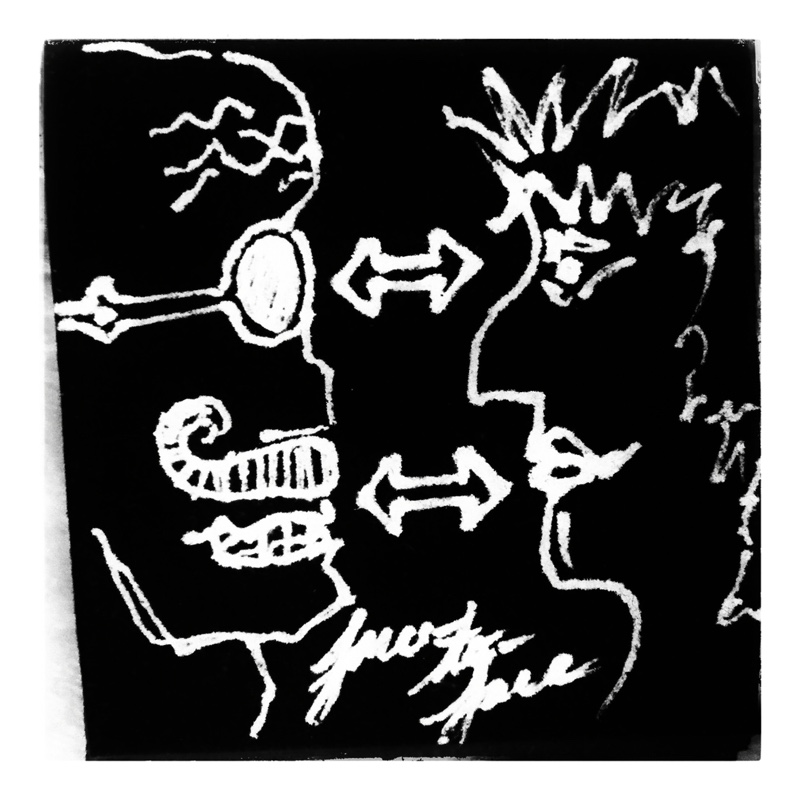
I was flattered recently to have an early post (12+ years is practically ancient in cyberlandia!) about flanerie (“What is a Flâneur?“) resurface in the blogosphere courtesy of The Concerned Canadian. In “The Art of Walking: Lessons from my Uncle” the author introduces us to his Uncle Philly, a wise, wondering, and wide-wandering Dublin flaneur.
It’s a good read.
The author touches on the difference between real life encounters (i.e. flesh-and-blood, non-digital interaction).
People want to know people. The current generation attempts to replicate this experience through the use of social networking and long distance communication. What’s missing though is the closeness which can only be created through face to face communication. (Source: The Concerned Canadian)
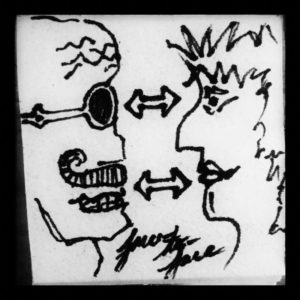 He’s on to something. I’ve ruminated before on the upside of digital flanerie, but the relative retreat from face-to-face interaction is real. Digital social networks and long distance interaction are remarkable in many respects, especially for those of us who remember life before the internet, mobile phones, 24×7 connectivity, etc. But they are at best a fuzzy phantom of face-to-face interaction.
He’s on to something. I’ve ruminated before on the upside of digital flanerie, but the relative retreat from face-to-face interaction is real. Digital social networks and long distance interaction are remarkable in many respects, especially for those of us who remember life before the internet, mobile phones, 24×7 connectivity, etc. But they are at best a fuzzy phantom of face-to-face interaction.
I am a collector of people, much to the regret of my tolerant bride, so I’m an easily sympathetic and an enthusiastic audience for The Concerned Canadian. It pleased me beyond description to read the words of a self-described millennial touting the merits of real life, face-to-face flanerie!
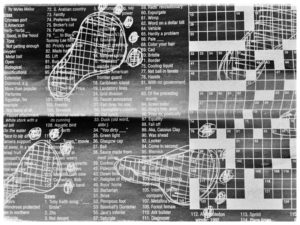
Thinking is generally thought of as doing nothing in a production-oriented society, and doing nothing is hard to do. It’s best done by disguising it as doing something, and the something closest to doing nothing is walking. ~ Rebecca Solnit (Source: Wanderlust: A History of Walking)
And, if the conditions are just right, sailing. Thinking. Walking. Sailing. Flanerie in a production oriented society…
@virtualDavis @Deerfield thanks for checking it out! go big green!
— Darlingside (@darlingside) March 15, 2016
@virtualDavis Sweeeet, thanks for listenin!
— Darlingside (@darlingside) March 18, 2016
You bet. You guys accompanied me on my North Country drive yesterday. Thanks! https://t.co/qhrIG1q1Im
— virtualDavis (@virtualDavis) March 19, 2016
“Pesticide is used to kill pests. Fratricide is when you kill your brother,” explains Darlingside’s Dave Senft. “A former teacher of ours used to say ‘kill your darlings,’ which is to say, if you fall in love with something you’ve written you should cross it out. We like that idea and we thought a good name for it might be ‘darlingcide’, but we changed the ‘c’ to an ‘s’ because we’re not super into death.” (Source: Darlingside)
I would love to include a link to the Deerfield magazine (where band member Don Mitchell went to high school), but it’s not online yet. Good article. Intrigued me enough to troll the internets for their sound. Found that intriguing video/song above and was doubly hooked. Doodle dreams?!?! And those harmonies of voice and strings…
“Each song and set of lyrics are created by all of us together, a sort of ‘group stream-of consciousness,’” Harris says. “So we moved away from a single lead vocalist and started gravitating towards singing in unison, passing the melody around, or harmonizing in four parts through an entire song.” Live and on record, they present a unified voice by clustering around a single condenser microphone and blending their voices in the room before they hit the mic. (Source: Darlingside)
I’m wearing out the CDs as I wind my way through this Adirondack spring. My favorite song? Whippoorwill. Enjoy.
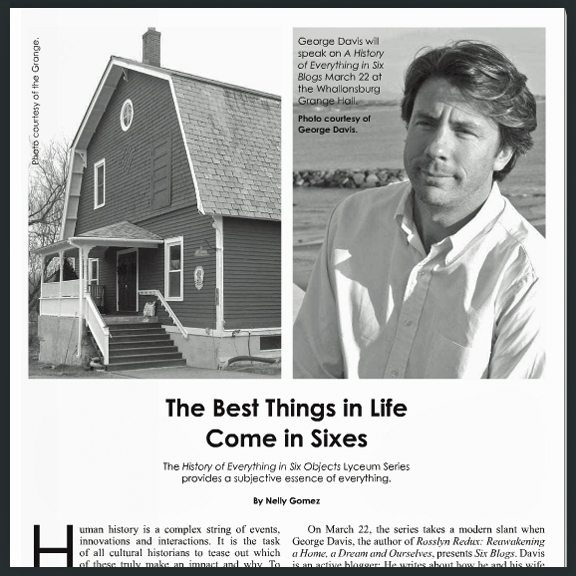
Six Blogs: Where is Hyperlocal Media Headed? March 22, 7:30 PM, Whallonsburg Grange (Source: Lake Champlain Weekly)
The Grange in Whallonsburg continues their Lyceum series on March 22 with a presentation by writer and blogger George Davis. The current Lyceum Series at the Grange presents the history, evolution and significance of everyday things in an extraordinary way. Presenters, like George Davis, will look at six objects and discuss why they have had a lasting impact. Davis’ presentation, titled “Six Blogs,” will begin at 7:30 p.m. Tickets are $5. For more information, call 518-963-4170. (Source: Sun Community News)
Thanks for the plug! And thanks also to Nelly Gomez at the Lake Champlain Weekly for this plug:

Ximena Maier (Source ximenamaier.com)
Ximena Maier (@lobster_squad) is a madrileña (but Scotland-based) illustrator, and she is — sin duda — my newest cartoon crush. My latest doodle dalliance. Right up there with Elizabeth Graeber, Oliver Hoeller (aka the visual flâneur), Mike Lowery, Hallie Bateman, and Keri Smith.
Ximena Maier… has been working as a full time freelance illustrator since 1999, mainly with Spanish newspapers and magazines. She also illustrates cookbooks, travel guides and children’s books. (Source: Ximena Maier)
I discovered Ximena Maier’s whimsical artwork when an Essex friend (and printer) shared a sumptuous letterpressed illustration of a scene from Anna Tasca Lanza‘s Sicilian cooking school. A delicate and doodle-y (not precious) black and white line drawing sumptuously sunken into paper nearly 1/8″ thick… Bliss.
It turns out that most/all of the illustrations at their website, annatascalanza.com, were created by Ximena Maier. If you like what you find, you may also want to visit Ximena Maier’s food blog, Lobstersquad, and her art blog, Ximenita dibuja.. Enjoy!
According to this video from Abe Books, “Chemists at University College, London have investigated the old book odor and concluded that old books release hundreds of volatile organic compounds into the air from the paper. The lead scientist described the smell as ‘A combination of grassy notes with a tang of acids and a hint of vanilla over an underlying mustiness.'” (Source: Huffington Post)
Secondhand bookstore fans are especially attuned to the olfactory wiles of dusty old tomes. Even as many of us shift our reading habits from printed books to digital books, we still wax nostalgic and romantic about the aesthetic pleasures of old book odor. But do old books smell like vanilla?
Stick your nose deep into an old book and inhale deeply… As it turns out, dozens of different chemicals that are emitted by paper, binding, ink, and glue… break down over time… One prominent compound results from the breakdown of lignin, a polymer found in plant cell walls, as well as paper. As it degrades, it’s converted into vanillin, a chemical naturally present in vanilla beans, accounting for the hints of vanilla. (Source: Vox)
I’m keen on old books and I’m keen on vanilla, but I’m not certain that old books smell like vanilla. According to Matija Strlic (the scientist who lead the 2009 study that has fueled recent aromatic rumination on old books), the grassy, tangy, and slightly vanilla smell of old aging books “is as much a part of the book as its contents.” I better keep sniffing…
Hat top to Todd Goff who brought the Vox article to my attention last summer. Yes, I’ve been dawdling and field testing ever since. Conclusions still pending!
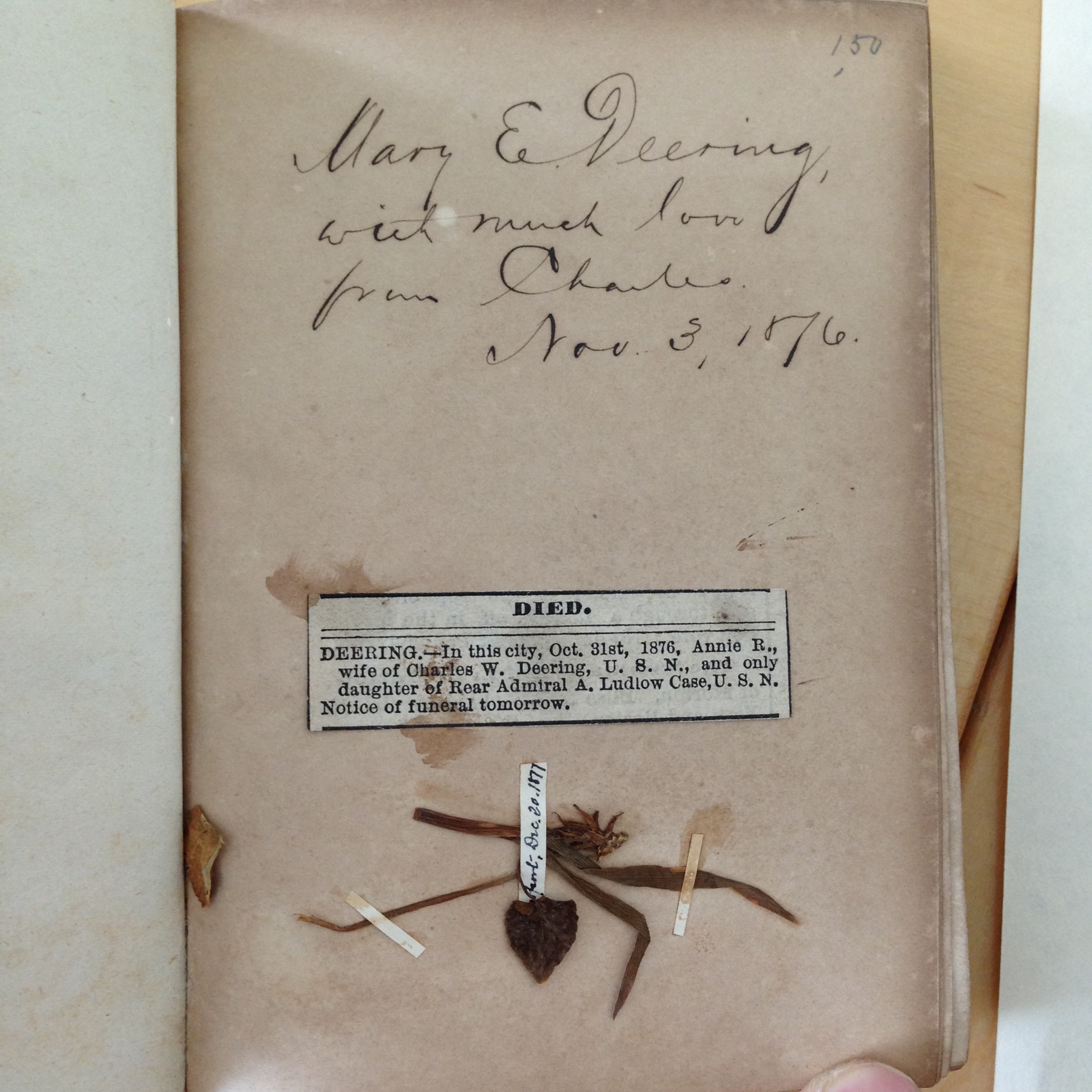
Marginalia: Book Traces
I return to the woeful fate of marginalia in the digital age. It’s worth noting that the image above first startled me as a spider tacked into a tawny tome. But this blessing of mistaken identity introduced me to Book Traces, and I am the richer (and more distracted) for it.
Book Traces is a crowd-sourced web project aimed at identifying unique copies of nineteenth- and early twentieth-century books on library shelves. Our focus is on customizations made by original owners in personal copies, primarily in the form of marginalia and inserts.
Sponsored by NINES at the University of Virginia and led by Andrew Stauffer, Book Traces is meant to engage the question of the future of the print record in the wake of wide-scale digitization… (Source: Book Traces)
As for that musty, magical photograph above?
Title: The Changed Cross and other Religious Poems
Author: Anonymous
Publication date: New York, 1872
Library: Richter, U Miami
Call number: PR 1191 .R24
Submitted by: Andrew Stauffer
Description: Memorial volume for Annie R. Deering, wife of Charles W. Deering and daughter of Rear Admiral A. Ludlow Case. Annie died just a few days short of their first wedding anniversary. Charles was 23 at the time, and Annie probably about the same age. Printed death notice attached. Gift inscription from Charles to Mary E. Deering, dated a few days after Annie’s death (on their wedding anniversary), November 3, 1876. Flower pinned to dedication page, with small slip dated Dec. 20, 1877. (Source: Book Traces)

Classic Dramatic Arc: exposition/rising action/climax/falling action/denouement (Source: Aeon Video)
What does neuroscience have to do with storytelling? What do cortisol and oxytocin have to do with a narrative’s dramatic arc? Perhaps everything!
“Stories that fail to follow the dramatic arc of rising action/climax/denouement—no matter how outwardly happy or pleasant those stories may be—elicit little if any emotional or chemical response…” ~ Dr. William Casebeer (Source: Future of Storytelling)
Too elementary? Too pedantic? Not so quick.
Paul Zak, an econ./psych./mgmt. professor at Claremont Graduate University has lifted the cranial hood on stellar storytelling and discovered that the dramatic arc powers effective storytelling.
“Stories are powerful because they transport us into other people’s worlds but, in doing that, they change the way our brains work and potentially change our brain chemistry — and that’s what it means to be a social creature.” ~ Paul Zak (Source: Brain Pickings)
Here’s the video you want to watch. And rewatch. And just possibly forward to your writing teachers, partners, mentors,…
Empathy, neurochemistry, and the dramatic arc Neuroscience suggests that the classic dramatic arc can change our brains and spur us to action. In this 6-minute documentary, a neuroscientist’s study suggests that the classic dramatic arc can change our brains and spur us to action. (Paul Zak, Future of StoryTelling 2012)
Here’s a tidy summary if you prefer reading to watching a video:
In this animated exploration of one of his most illuminating experiments, [Paul] Zak discusses the surprisingly calculable effects that the classic dramatic arc (exposition/rising action/climax/falling action/denouement) has on our brain chemistry and, ultimately, on our decisions and actions.
Monitoring the brain activity of hundreds of study subjects watching a video with a simple narrative, Zak found increases in the levels of the neurochemicals oxytocin and cortisol, which are associated with empathic responses. Most remarkable, however, was the discovery that this response also resulted in study subjects taking action, in this case through donating money they had just earned to a charitable cause related to the story they watched and even to fellow subjects. Zak’s conclusion that there could be a universal story structure that functions to connect us to each other might not be surprising to storytellers, but seeing it supported by neuroscience is a tale worth repeating. (Source: Aeon Video)
Indeed. Repeating and practicing. Thanks, Paul Zak for confirming what we storytellers already knew (or claim to know) but sometimes overlook. Or ignore. At our narrative’s peril!
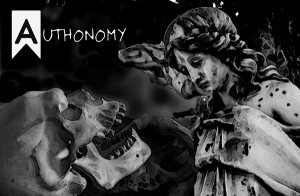
RIP Authonomy: HarperCollins to close online writer community on October 1.
It is with great sadness that we must announce the closure of Authonomy.
We created Authonomy in 2008 as a way of discovering new talent by throwing open our doors to unagented, aspiring writers, and asking likeminded writers and readers to help us discover and champion great work…
HarperCollins remains committed to discovering new writers, and this is reflected in our dynamic, genre-focused, digital-first lists such as HarperImpulse, and our open submissions windows for innovative commercial imprints such as Voyager and The Borough Press. We would encourage the very talented members of the vibrant Authonomy community to continue to show us their work through these channels. (Source: Authonomy Blog)